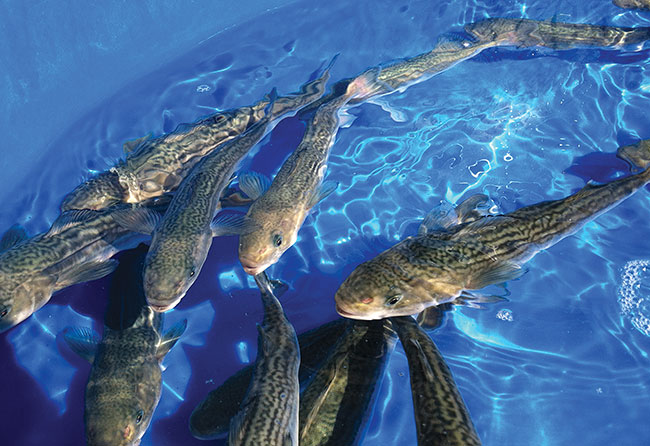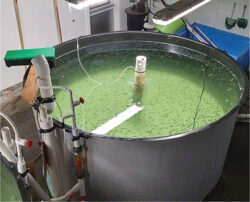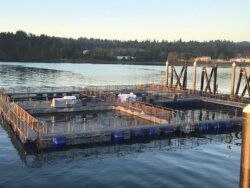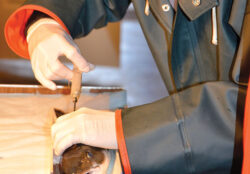
Science is a strategy: Farming for sablefish
July 12, 2023
By Lynn Fantom
But will it sway Washington state regulators to re-open net pen farming for sablefish
 Sablefish, a deepwater species native to the Pacific Northwest and Alaska, are a potential species for commercial farming. Photo: NOAA Fisheries
Sablefish, a deepwater species native to the Pacific Northwest and Alaska, are a potential species for commercial farming. Photo: NOAA Fisheries A first-in-the-U.S. pilot research project to develop sustainable practices for farming sablefish has now progressed to the point that a full-color sales sheet can boast to wholesalers about the “pearly white flesh, large velvety flakes, and sweet, rich flavor” of this native deep-sea fish, long a traditional food of the indigenous people of the Pacific Northwest.
The sablefish comes from the experimental net pens at the Manchester Research Station on Puget Sound in Washington, the result of a research collaboration and partnership among NOAA Fisheries’ Northwest Fisheries Science Center, the Jamestown S’Klallam Tribe, and the University of Washington.
While scientists have overcome many daunting challenges during the pilot project, social and political pushback against aquaculture cloud the future of exactly how and where commercial rollout will occur in the U.S. The precedent already exists in Canada at Golden Eagle Sablefish in British Columbia, which is producing sablefish in partnership with the Kyuquot-Checleseht First Nations.
Similarly, the Northwest Fisheries Science Center aims to develop and transfer knowledge and technology to the Jamestown S’Klallam tribe (or any interested party) to help initiate commercial-scale operations in the United States.
A decade of science
“The research team at NOAA over the last decade has really optimized many of the culture methods—everything from spawning fish to larval rearing to producing juveniles that grow quickly,” said Ken Cain, who joined NOAA Fisheries last October to oversee the Aquaculture and Marine Fish and Shellfish Biology Program.

Researchers over the last decade have optimized culture methods — including spawning fish and larval rearing. Photo: NOAA Fisheries
The work hasn’t been easy. First, to spawn brood stock, researchers have had to mimic the natural conditions of deep water (over 300 m/1,000 ft) with its low temperatures (around 5°C/41°F) and darkness. They use only red lights “during these critical times,” Cain noted. Because adult female brood stock do not release all of their eggs at once, they must be checked every couple of days to remove eggs, each of which is about the size of a sharp pencil point. The tiny eggs then go into incubators where they take a few weeks to hatch. The embryos can derive nourishment from their yolk sacs for another month, but then they need to be fed.
Unlike salmon, which can feed initially on dry commercial products, larval sablefish require live feeds. So, the NOAA scientists have to produce small marine plankton called rotifers. The larvae also prefer opacity in the water, which is created by the presence of algae. To reduce costs, researchers have substituted clay for algae – an important step in creating long-term economic viability. They are also working on reducing the cost of rotifer feed by replacing algae with yeast. Still another cost-saving step under study is to substitute commercially available liquid artemia feeds for live ones.
Work is also very hands-on. Once fish are started on feed, they must be graded by size because of cannibalism. “There’s always some fish that don’t want to feed on something that’s not moving around,” said Cain. “Once they get bigger than everyone else in the tank, it doesn’t take them long to reduce the population pretty quickly.”
Another goal at the Manchester Research Station is to have cultured female fish in captivity maturing and spawning consistently. That would eliminate the need to collect wild brood stock – both an expense and a challenge in cases of inclement weather. It would also allow selective breeding. “Ideally, we would select the fastest growing fish and breed those” to reduce the time to market, which is 18 to 24 months rather than what currently exists within the trout market as under a year, said Cain. Environmental cues, like salinity and temperature, may provide the answers for researchers.
A new project is also focused on a vaccine to prevent a non-typical furunculosis, a bacterial disease that can be a problem for sablefish, but not salmon, when waters warm. “It is the only disease issue that has been a major concern,” Cain noted.
In terms of research challenges, there are no deal-breakers. But, Cain said, “there’s clearly an opportunity to continue to reduce costs and to prove that it could be successful in systems other than net pens.”
The philosophy behind the work
Work is now beginning on a grant-funded project to compare growth rates in net pens with both land-based recirculating aquaculture (RAS) and flowthrough systems. The data will provide the opportunity to assess whether these alternatives are economically and environmentally feasible, factoring in electricity and water usage. “There are always trade-offs,” said aquaculture veteran Jim Parsons.

Experimental net pens at the Manchester Research Station on Puget Sound are used for grow-out in the pilot project.
Photo: NOAA Fisheries/James Hackett
In 2021, he accepted the role of CEO at Jamestown Seafood after the tragic death of founder Kurt Grinnell, a member of the Jamestown S’Klallam Tribe, who launched the company in partnership with the tribe in 2016. It is expected that by year’s end all Grinnell family assets will be transferred to the tribe which will then wholly own Jamestown Seafood, Parsons said.
The former executive of Troutlodge and Cook Aquaculture notes that, along with the “tremendous growth rate” of juvenile sablefish, there’s good feed conversion efficiency—“even on diets that we have not perfected yet for that fish.” According to Cain, some research has already been done showing sablefish do well on low-fishmeal diets.
The work this year also includes testing the marketplace with the 10,000 to 12,000 fish harvested at Manchester Research Station. The strategy, said Parsons, is to fill in the gaps when sablefish are not available from the wild fisheries due to declining fishing quotas and harvest restrictions during spawning season. Jamestown does not want to compete against wild-caught sablefish. Food independence is more the issue. “It takes everybody in this country growing seafood or catching seafood to keep it from being imported,” he said.
Part of the marketing program is a sustainability statement that notes use of the Japanese fish slaughter technique ike jime which causes instantaneous death. Sushi chefs, along with other high-end restaurants, are key targets.
Science, hard work, and a little help from friends
The very first point in the sustainability statement is that the sablefish program is dedicated to farming a traditional fish eaten among the S’Klallam peoples and using it as a form of economic development for a rural area. “Channeling Kurt [Grinnell] and listening to the Jamestown S’Klallam tribal leadership, I think all of us would be good to remember what they believe: What is done today can impact seven generations from now,” said Parsons.

Juvenile sablefish, shown here being tagged, have a “tremendous” growth rate and good feed conversion efficiency.
Photo: NOAA Fisheries
But, NOAA only has a 5-year permit to utilize net pens for research and assessment of the grow-out feasibility for sablefish at their research station.
Last November, as critics continued to argue that net-pen aquaculture can spread disease to native stocks and degrade the environment, Public Lands Commissioner Hilary Franz issued a ban on all net pen farming in Washington state waters. In a complaint filed in December, the Jamestown S’Klallam Tribe, as a “federally recognized sovereign nation,” asserted Franz’s action impinges on its tribal rights, maintaining it could “produce seafood in a sustainable and environmentally protective manner.”
To that end, collaborators from the University of Washington have been analyzing the effects of the net pen production on sediments beneath and surrounding the pens.
And an upcoming goal is to examine polyculture with sea cucumbers. These detrivores feed on decaying organic matter in coastal sediments, making them a potentially valuable partner in integrated multi-trophic aquaculture (IMTA). Interest has also been expressed in IMTA with seaweed.
“There’s got be some creativity that comes into play here to bring people around to see aquaculture is (a) not what it used to be and (b) not all that bad” said Parsons.
In May, Washington Superior Court ruled that the Northwest Aquaculture Alliance (NWAA) will be allowed to intervene on behalf of its members in the Jamestown S’Klallam Tribe’s lawsuit. NWAA’s intervention request stated that Franz’s total commercial ban appeared
“untethered to the specific science of other expert agencies.”
Reflecting on the project and its prospects, Parson added, “We’re making headway that science will eventually win out, right? The earth is not flat, it’s round.”
Advertisement
- Innovative Microfluidics Tech Revolutionizes Pathogen Detection, Genetic Research
- Bio-ropes could help reduce carbon footprint of aquaculture operations





